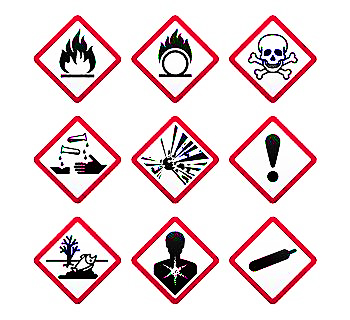GHS Compliance Clock Ticking Away
Less than one year away, June 1, 2016, is the final deadline by which OSHA expects U.S. employers to fully comply with its 2012 final rule revising the Hazard Communication Standard, which the agency has dubbed the "right to understand" standard to differentiate it from the previous "right to know" regulation. By that date, employers should have their workplace labeling procedures in place and all employees trained.
 So the clock is ticking. A May 2015 memorandum to OSHA regional administrators from Thomas Galassi, director of OSHA's Directorate of Enforcement Programs, was issued three days before the most recent deadline, June 1, for manufacturers to be producing safety data sheets and labels compliant with the Globally Harmonized System (GHS) format. In it, Galassi indicated many chemical suppliers would miss that June 1 deadline.
So the clock is ticking. A May 2015 memorandum to OSHA regional administrators from Thomas Galassi, director of OSHA's Directorate of Enforcement Programs, was issued three days before the most recent deadline, June 1, for manufacturers to be producing safety data sheets and labels compliant with the Globally Harmonized System (GHS) format. In it, Galassi indicated many chemical suppliers would miss that June 1 deadline.
He referred to a Feb. 9, 2015, memo that said OSHA inspectors should take into account good-faith efforts by chemical manufacturers, importers, and distributors trying to comply with the revised standard but having not received classification and safety data sheet information from their upstream suppliers. "Since issuing the guidance on February 9, 2015, OSHA has received an overwhelming number of additional questions and requests for further clarification on behalf of manufacturers, importers, and distributors. Many of the questions relate to the use of HCS 1994-compliant labels on containers packaged for shipment (i.e., existing stock)," the memo stated.
The revised standard says manufacturers and importers must classify the hazards of chemicals they produce or import, and distributors must transmit the required information to employers. Employers then must provide information to their employees about hazardous chemicals to which they are exposed, using a hazard communication program, labels and other forms of warning, safety data sheets, and information and training.
The revised standard allows distributors to continue shipping chemicals with labels that meet the old standard, but only until Dec. 1, 2015.
The final rule explains how chemical labeling is to be done: Employers are to ensure that each container of a hazardous chemical is labeled with a product identifier, signal word, hazard statement(s), pictogram(s) and precautionary statement(s). However, this does not apply to portable containers into which hazardous chemicals are being transferred from labeled containers and which are intended only for immediate use by the employee making the transfer.
In addition, employers "may use signs, placards, process sheets, batch tickets, operating procedures, or other such written materials in lieu of affixing labels to individual stationary process containers, as long as the alternative method identifies the containers to which it is applicable and conveys the information required . . . to be on a label," the final rule states.
OSHA has made a wealth of information about the new standard available on its website, everything from a "Steps to an Effective Hazard Communication Program for Employers That Use Hazardous Chemicals" fact sheet to the Galassi memos, a side-by-side comparison of the old and new standards, and much more.
Posted by Jerry Laws on Jul 15, 2015